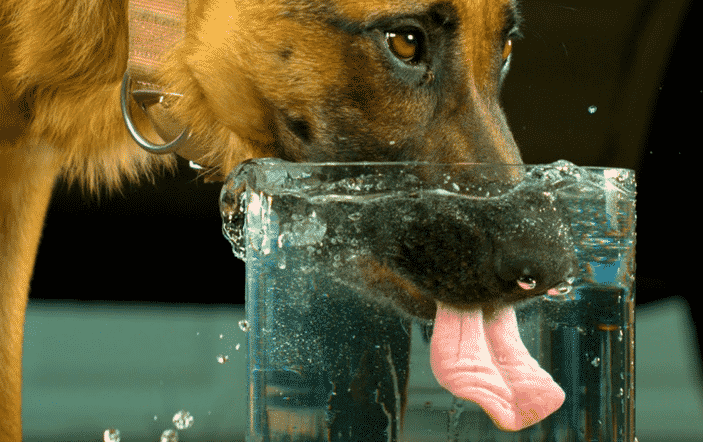Low sodium in dogs has many causes and symptoms that range from mild physical to severe neurological symptoms and death.
A study on Incidence, Severity, and Prognosis Associated with Hyponatremia in Dogs and Cats associated hyponatremia “increased case fatality rate than normal blood or serum sodium concentration.” Therefore, if you see any symptoms, we will look at, notify your vet for diagnosis and treatment.
Overview
Sodium is important in dogs. It has many vital roles in a dog’s body that includes maintaining the volume of blood and body fluids, helping in cell signaling (never impulse transmission), muscle function, balancing pH, and electrolytes, just but to mention.
Most of the sodium in a dog’s body is concentrated the fluids outside a dog’s cells (extracellular cells) that include blood plasma, interstitial fluid with only a small amount of transcellular fluids.
These animals must maintain a well-guarded range of sodium concentration in their bodies. A typical range of 140 -149 mE/L (mmol/L).
An excessive high amount of this mineral in a dog’s extracellular fluids (ECF) will result in sodium poisoning or hypernatremia, whose symptoms can range from mild to fatal depending on the level of intoxication.
On the other hand, should the sodium concentration in blood plasma go below the normal range i.e, below 140 mE/L (mmol/L), your dog will suffer from hyponatremia, a condition we will be talking about in this discussion.
Understanding hyponatremia
As already hinted, most of the sodium ions (Na+) are restricted fluids outside cells and blood plasma. If Na+ concentration in blood plasma and by extension extracellular fluids goes down, water will move into body cells due to the low osmotic pressure of these extracellular fluids.
When this happens, your dog will have both physical and neurological signs as their body cells, including brain cells, will begin to swell.
Signs and symptoms
The severity of the symptoms will depend on the extent to which hyponatremia happens. Common symptoms expected include the following:
- Listlessness, dullness, or lethargy (lack of energy)
- Nausea and vomiting
- Reduced appetite
- Dry, tacky mucous
- Neurological symptoms like your dog being less alert, disoriented, confused, reduced muscle strength, tremors, seizures, and coma.
- Death
- Some symptoms may be of the underlying disease and conditions that cause hyponatremia.
Low sodium in dog causes and types
There are three types of sodium-water imbalance may occur, i.e.:
- Hypovolemic hyponatremia: It involves a decrease in both sodium and total body water. However, there is a great loss of Na+ leading to its lower concentration in extracellular body fluids.
- Euvolemic hyponatremia: This type occurs when body fluids remain more or less the same, but there is a total water increase without a corresponding rise in Na+.
- Hypervolemic hyponatremia – This occurs when both total body water and sodium increase, but there is a more increase in the amount of water as opposed to the amount of Na+.
Some of the causes of the above three types of hyponatremia include but not limited to, the following:

- Diarrhea, vomiting, loss via skin burns, and third space losses or loss into body cavities such as in the cause of peritonitis, which results in more sodium loss.
- Excessive urination and action of diuretics (trigger more urine production).
- Excessive water consumption, including due to psychogenic polydipsia, a compulsive water consumption disorder.
- Antidiuretic medications (trigger fluid retention) like some chemo drugs, tricyclic antidepressants, beta-adrenergics, oxytocins, serotonin reuptake inhibitors, cyclophosphamide, vincristine, among others.
- Mannitol or glucose infusion or due to high lipids in the blood (hyperlipidemia or hypertriglyceridemia). These infusions make water move from cells to extracellular fluids resulting in isotonic hyponatremia.
- Rapid administration of intravenous fluids.
- Addison’s disease (hypoadrenocorticism) and congenital adrenal hyperplasia
- Pancreatitis
- Hyperthyroidism (underactive thyroid glands)
- Less ACTH and SIADH (syndrome of inappropriate antidiuretic hormone secretion), an antidiuretic hormone that helps in the regulation of thirst and renal actions.
- Any hepatic disease in its advanced stages including liver cirrhosis, PSS or fibrosis
- Kidney failure, nephrotic kidney syndrome, obstruction, or rapture of the urinary tract.
- Congestive heart failure
- Intracellular translocation associated with sodium moving from extracellular cells into skeletal muscles that may occur due to issues such as severe muscle injury.
- Low sodium diets. However, this doesn’t include some of the best low sodium dogs sold commercially as they meet the minimum recommended amounts.
- Severe cases of hyperglycemia caused by diabetic ketoacidosis or mellitus.
Diagnosis
If your canine has any of the above symptoms, take him to your vet for diagnosis, which may involve physical examination, asking on patient history, and conducts tests to assess sodium level in blood and urine.
Typical blood tests that may include complete blood count, osmolality tests, metabolic panel, and an electrolyte panel. The other test is a urinalysis, which may involve getting parameters like urine osmolality, sodium concentration, and so on.
Treatment
Treatment will involve correcting the issue using slow intravenous sodium solution as rapid will cause cerebral edema, tremors, seizures, obtundation, and so on. However, if patients have neurological signs, they may require diazepam to control them.
Once sodium levels have been restored, your vet will change his focus on managing or treating underlying causes as well as guide you on recovery and living management.
Living management
Post-treatment prognosis is pegged mainly to the underlying cause. However, you will need to have continuous routine checks to ensure the sodium levels don’t go down again. Also, you should understand and notice symptoms that signify the onset of hyponatremia.
